
The Yamaha CR-800 receiver made its debut in 1974 with a retail price of $580.00. It was number 2 in the Yamaha lineup just behind the top of the line CR-1000. It produces 45 watts per channel with 0.1% total harmonic distortion and employs Yamaha’s Natural Sound circuitry for clean and crisp sound. The clean, stark styling and sleek, low profile cabinet give the CR-800 a premium look and feel.
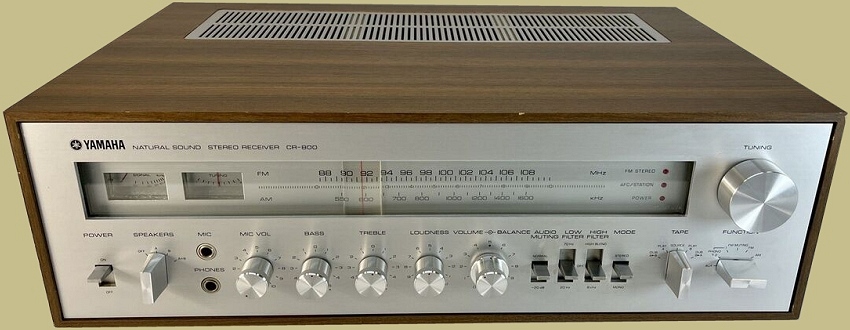
Front Panel
The Yamaha CR-800 receiver has a clean, minimalist style typical of Yamaha gear at the time. The main design feature is a big rectangular cutout for the dial that takes up a large portion of the brushed aluminum front panel. Unlike the dark “blackout” dials on a lot of the receivers of the time, the CR-800’s dial has a matching brushed silver finish under a clear window.
The FM tuning scale is linearly marked in 0.5 MHz increments. It uses a wide, clear plastic pointer with a thin red line to precisely tune stations. The signal strength and FM center meters are to the left of the dial, and power, stereo, and auto tuning indicator lights are on the right.
Below the dial are smaller knobs for bass, treble, microphone volume, loudness compensation, and main volume/balance. The tone and loudness controls have 11 detented steps, and balance is centered. Yamaha’s loudness system is unique – it lets you fine tune compensation to your exact volume setting for optimal performance. Stereo Review said: “The loudness compensation system impressed us as one of the best we have used”.
Here’s how to use the Loudness control on the CR-800:
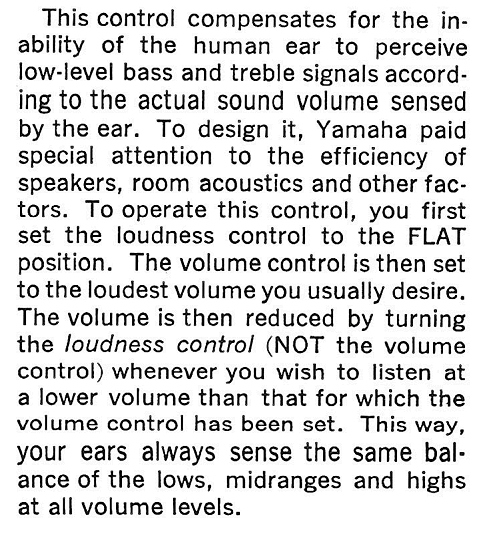
The mic volume knob allows you to control a microphone plugged into the front jack. The mic mixes with the main signal but doesn’t get sent to the tape out jacks. There is also a headphone jack that allows for private listening.
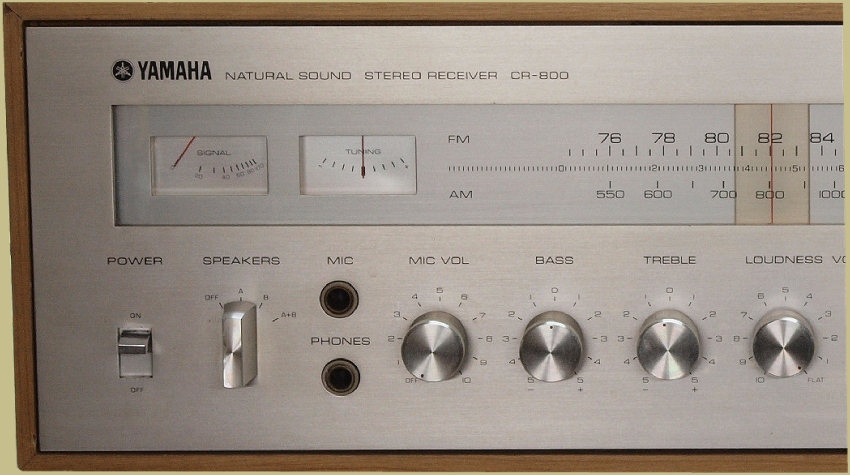
Three bar switches let you select speaker pairs (A, B, A+B, or off), choose inputs like phono, FM, AM, or aux, and monitor tape decks. The tape monitor loops let you listen to a tape deck or dub between them.
Lever switches handle power, muting (drops level 20dB), mono/stereo mode, and high/low filters. The filters have center-off positions. The low filter cuts bass below 70Hz or 20Hz to remove rumble. The high filter has an 8kHz setting to reduce hiss, plus a blend mode. Blend reduces separation at high frequencies to cut hiss, but leaves the frequency response intact.
So, the CR-800 gives you a lot of options to optimize performance. Whether it’s fine tuning the bass and treble, blending channels to reduce noise, or switching between multiple components, the various controls make it really versatile. Yamaha put some thoughtful engineering into this receiver to handle different media and situations.

Tuner
The CR-800 has a really sensitive FM tuner section to pull in stations clearly. It uses two low-noise dual-gated MOSFETs in the RF amplifier and mixer stages. These help deliver excellent sensitivity and tune in even weak stations with minimal background noise.
The intermediate frequency (IF) amplifier is another technical highlight. It has a discrete differential amplifier, two integrated circuits with six differential amplifiers total, and three precisely tuned ceramic filters. This results in excellent phase linearity and great bandpass filtering in the IF section. It gives the tuner over 80dB of selectivity, so you can tune in a station cleanly even if another station is at a nearby frequency. It also has low distortion (0.15% mono, 0.3% stereo) for crisp, clear sound.
The CR-800’s FM tuner borrows a lot from Yamaha’s high-end CT-7000 tuner which was one of the most advanced tuners on the market at the time.
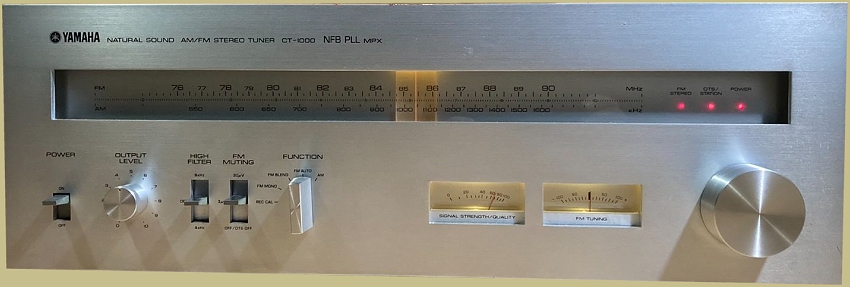
The layout looks similar to the CT-7000 and the design and performance similarities are striking. Yamaha clearly adapted many of the CT-7000’s innovations when developing the CR-800’s tuner.
The bottom line is, with the CR-800, you’ll be able to tune in your favorite stations, even in big cities with lots of interference, and enjoy the crisp, clean FM sound.
Specifications
- Power output: 45 watts per channel into 8Ω (stereo)
- Frequency response: 10Hz to 50kHz
- Total harmonic distortion: 0.1%
- Damping factor: 70
- Input sensitivity: 3mV (mic), 3mV (MM), 150mV (line)
- Signal to noise ratio: 70dB (mic), 75dB (MM), 90dB (line)
- Channel separation: 50dB (MM), 50dB (line)
- Output: 150mV (line), 0.775V (Pre out)
- Speaker load impedance: 4Ω to 16Ω
- Dimensions: 474 x 158 x 300mm
- Weight: 14kg
- IF Output for 4-Channel Capability
- Separable Preamplifier and Power Amplifier
- Connects Two Pairs of Speaker Systems
- Two Phono Input Circuits
- Four AC Outlets
- Headphone Jack
- -20dB Audio Muting Switch
- One-Touch Speaker Terminals
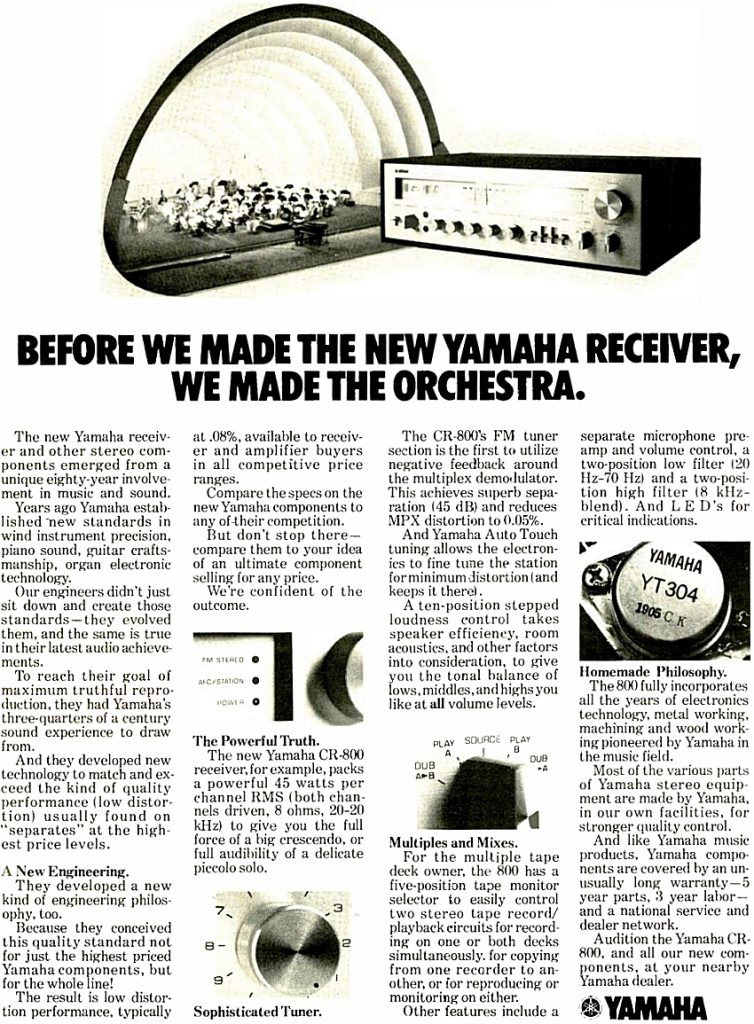
Amplifier
The Yamaha CR-800 uses a direct-coupled complementary amplifier design that results in crisp, clear sound. Basically, it directly connects two types of amplifiers – a differential amplifier and a complementary amplifier without output capacitors. By linking these amplifiers directly, the CR-800 can evenly apply negative feedback across the full audio range – from the lowest bass frequencies all the way up through the audible spectrum above 20,000Hz. This helps reduce distortion to very low levels – just 0.5% total harmonic distortion. It also helps the amp deliver excellent transient response and tight, controlled bass by keeping the damping factor steady even at very low frequencies.
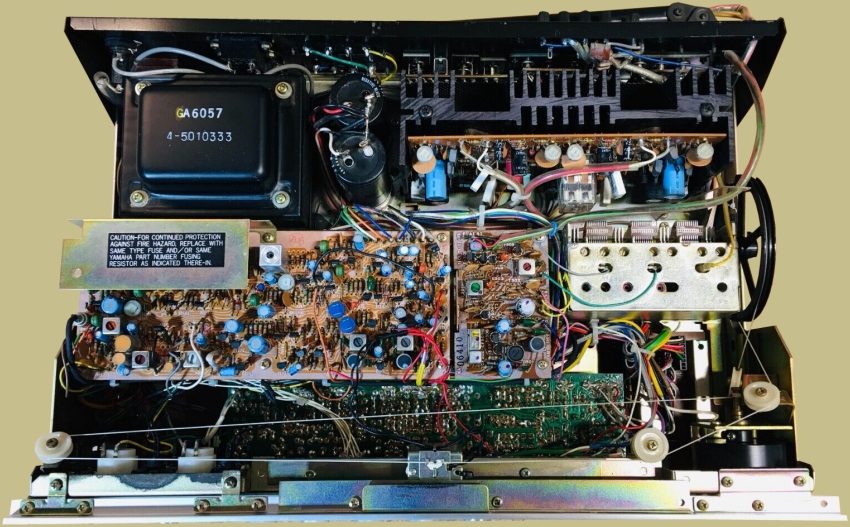
When an audio magazine tested the CR-800 back in 1975 they said this:
For the most part, our tests showed that the published figures were extremely conservative. The power output at clipping with a 1,000 Hz input signal into 8 ohm loads, both channels driven, was 61 watts per channel. At Yamaha’s rated 45 watts output and at lower power levels, the THD was less than 0.035 per cent from 20 to 20,000 Hz and typically less than 0.015 per cent.
The Yamaha ideal was that the signal that goes into the amplifier should come out amplified but otherwise unaltered. Some don’t favor the clean sound that Yamaha’s natural sound receivers produce. They say they lack warmth. Others love the extended high frequencies and lifelike sound.
Reviews
The tuner is crystal clear and pulls in all my local stations with ease. The phono preamp sounds wonderful. Finally, the real wood cabinet makes the CR-800 look like a piece of vintage art in my living room. If you’re contemplating a CR-800 for yourself, don’t hesitate to pull the trigger – you will not be disappointed.
One of the best-built Japanese receivers of all time but packed to the gills with hundreds of discrete components, making for comparatively lengthy servicing.
Sheer delight even at very low listening levels. Every switch & dial operates as smooth as glass.
The CR-800 is one of my favorite vintage pieces…it has a very clean open sound that is very satisfying. It doesn’t get much better than this vintage wise!
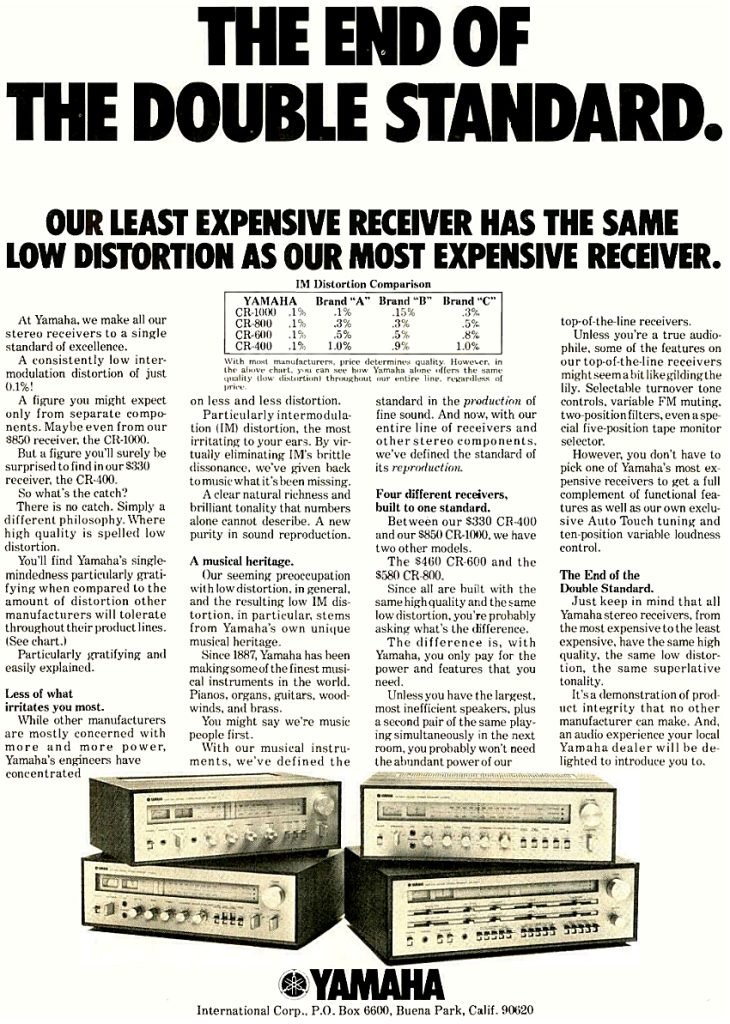
Rear Panel
Around back, the CR-800 has connections for all your audio gear. There are inputs for two Phono, an Aux, and two tape decks. There are separate preamp outputs and main amp inputs that a slide switch patches together. The two sets of speaker terminals use insulated spring clip connectors for secure hookup.
For radio, the AM antenna is a pivoted ferrite rod plus terminals for AM and FM antennas. And the CR-800 conveniently includes four AC outlets – two switched and two un-switched – to power accessories.

The Yamaha CR-800 offers an exceptionally well rounded package with few real weaknesses. If you like a receiver with a sleek, minimalist look, clean sound, and exceptional performance then the CR-800 is definitely worth looking at. There are a lot of receivers out there to choose from but when it comes to performance in the areas that matter for enjoying music and radio there aren’t many better.
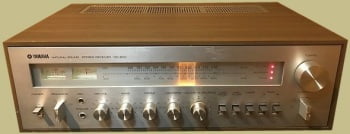
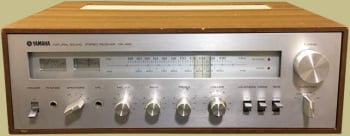
Firstly let me just say that I am mainly a Pioneer man. SX 650 receiver, TX 7800 receiver and SA 7800 amplifier combo, also SX 790 which are all in the same ballpark power wise. They are very good if somewhat unsubtle.
BUT I have always been intrigued by the Yamaha tuner technology and especially loudness treatment from the 1970s.
So I aquired a Yamaha CR-800 out of interest mainly. Hooked it up to a new pair of Wharfedale Linton Heritage speakers (6ohm). Blown away am I. The quality is outstanding. Locking onto a station, it absolutely nails it with the least interference and the best signal, using the same aerial as for my my TX 7800 receiver which I had thought was the best, this is better. Very clean and focussed with very little abstract noise. Can keep it in stereo whereas lesser tuners one has to default to Mono to get clarity. The phono stage is outstanding and lacks for nothing.
As for the loudness knob, yes knob, not a switch, amazing. Set the volume as loud as you can bear, then use the variable loudness control to reduce it and it has the best audio response I have ever heard at lower volumes. Nice grunty base is still there (despite people saying Yamaha lacks base- they are wrong) but still balanced by proper midrange and treble. One gets used to this disappearing at low volume, but not with this Yamaha.
I can’t really fault this receiver except the blingy lights I had been used to with Pioneer have been replaced by the oh so sophisticated dimness of Yamaha. There are no controls it lacks and all that is missing in the eternal quest for audio perfection is a VU Meter which or two which should be compulsory and which Pioneer does in spades.
As a design icon it is a total winner especially with those rectangular selector knobs and overall has a somewhat Scandinavian vibe, but being a Brit I see it as more like a vintage Jaguar against a Ford Capri.
Nice.